its paid sponsors, whose products you need!
| Home |
| Intro |
| Current Issue |
|
Mailing List |
| Store |
| Strength |
| Subscriber Content |
| ARCHIVES
|
| Martialism |
| Pacifism |
| Q & A |
| Cunning-Hammery |
| Advertise With Us |
| Submit An Article |
| Staff |
| Discussion Forum |
| Links |
“Stay ‘unreasonable.’ If you
don’t like the solutions [available to you], come up with your
own.”
Dan Webre
The Martialist does not
constitute legal advice. It is for ENTERTAINMENT
PURPOSES ONLY.
Copyright © 2003-2004 Phil Elmore, all rights
reserved.
Budget-Friendly Survivalism
By Phil Elmore
Say the word “survivalism” to most people and their eyes
will glaze over, even if they don’t just call you “nuts.” Most people
picture garages full of ammunition and tanks of water, rough-hewn retreats
from which to combat the black helicopters, and other fringe lifestyles that
don’t apply to the population at large. Even those of us who are not
opposed to idea of survival (such as suburbanites like myself) tend to become
complacent when considering the survival gear we ought to have on hand. There
are any number of items you can and should be carrying, even if the farthest
distance you travel daily is the few miles of asphalt between your condominium
and your office job. These items don’t have to cost a lot. They don’t have to
take up too much space, either. What they will do is make your life
easier in an emergency.
Your car is a great place to carry a variety of gear. Driving a car at
all demands that you be prepared for certain problems, ranging from
inclement weather to mechanical difficulty to civil unrest. Everything
you could ever want can be carried in a trunk in an inexpensive, waterproof
ammo can from your local military surplus store. I suggest you strap it
down with paracord so it won’t shift while you’re driving.
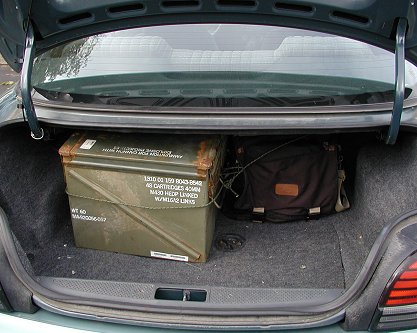
Large military ammo can makes a great
storage bin.
Your trunk supplies should include a shovel for digging out
of snow and mud. The folding military entrenching tool is a great option. It
takes up little space, it’s very tough, and it can be wielded like an axe for
use as an expedient self-defense weapon. You should also have simple hand
tools pliers, screwdrivers, and adjustable wrenches, for example as well
as jumper cables and possibly a gasoline siphon and funnel. A crowbar is a
good lever for when you’re stuck and it, too, can be used for self-defense.
It doesn’t hurt to have safety glasses, either (an idea I picked up from
Massad Ayoob). My work as a technical writer sometimes takes me into factories
and other industrial environments where eye protection is required, which is
why I carry them, but working in and around an automobile is a potentially
hazardous activity for which eye protection is useful.

Carry all the tools and accessories
you might need in an emergency.
If you live in an area where you could be stranded in cold
weather, make sure you have boots, gloves, and a heavy coat in the trunk (in
case you get caught without them). A scarf can do double duty as a hat and ear
protection. If you need glasses or contacts in order to see to drive, make
sure you carry a backup pair of spectacles in your car in case you break or
lose your lenses while you’re far from home. I know I’d prefer not to try and
squint my way through highway traffic.
Paracord is one of those supplies that seems to have a
million and one uses. You can buy loops of this stuff from discount
stores in the camping section. Mil-spec cord is available online from
numerous suppliers. Keep a small pair of scissors with the paracord, as
well as a lighter (or even a book of matches) for heating and sealing the
ragged ends.
Food and water is one of those things that should be tucked
away inside your vehicle. Just before the Y2K Scare proved bogus,
companies online were selling these neat little cardboard survival kits that
included juice-box-sized containers of water, energy bars, light sticks, and
other survival goodies, presumably because your family would be huddled
together in the post-apocalypse with nothing else to eat or drink. One
of these kits can easily fit in a corner of your trunk in case you’re stuck in
a blizzard or lost by the side of a dirt road somewhere.
Don’t forget to stock your glove compartment with maps, your car’s manual, and
whatever else you use frequently. Leftover space should be devoted to small
survival items, like the prepackaged survival tins you can buy online or from
catalogs. Each little tin is different (and you can even make your own, such
as the AOL Survival Tin). The one in my glove
box has things like fish hooks, a pencil and paper, a tiny pocket knife, a
small candle, and numerous other thoughtful odds and ends.
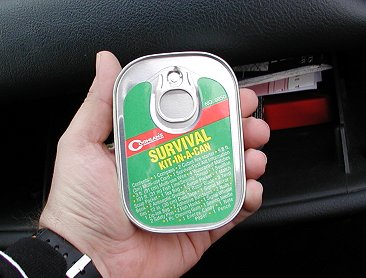
Sealed tins like this are available
commercially.
Keep handy a sealed travel packet of painkillers, like
Asprin or Tylenol. Anti-bacterial towelettes are another useful clean-up item
when you’re on the road. Add a commercially purchased portable first-aid
kit to round out your emergency items.
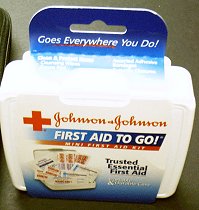
I bought this first-aid kit at an
office-supply store.
Knives are always useful items and you should carry one if
you can. However, when stocking your car, be aware of your local laws.
In some states it’s illegal to carry a knife of significant size in your
automobile. In other municipalities, it may not be against the law, but it
might make your friendly traffic cop nervous and prompt him to give you
trouble. Consider what you’ll have to explain if your vehicle is searched for
whatever reason.
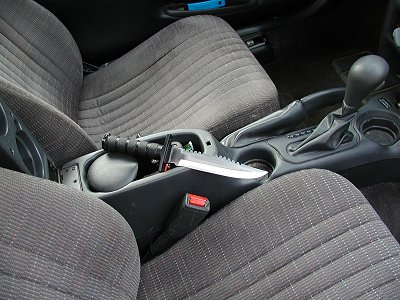
This might not be the best option,
depending on the law.
The office worker’s best friend is the
expandable briefcase or tactical shoulder
bag. Before I switched to a shoulder bag, I carried a ton of gear in
my briefcase (along with my actual work).
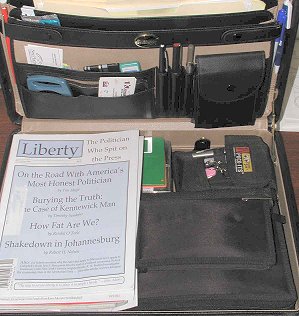
The
Pock-Its utility pouch
forms the foundation of my survival kit and is a great way to organize
different items. It doesn’t take up much space, but it holds more than
you might think.

Technically called a “utility holster,” the
Pock-Its case is an inexpensive nylon pouch with
various pockets and loops,
into which
I placed items purchased at local discount and retail
stores. None of the items is very expensive the multitool is
probably the most costly of all of them but having them has helped me
many times.

Emptied, the kit contains the following items, all of which are
extremely useful in emergencies:
-
Butane lighter
-
Small folding hacksaw
-
Leatherman multitool
-
Locking folding knife (selected for its flat profile)
-
Diamond sharpening rod in pen-cap case
-
Nail clippers
-
2AA Flashlight
-
Sewing kit
-
Smaller locking folding knife (part of first aid kit)
-
First aid kit (containing small adhesive bandages and first aid
card) -
Small Swiss Army Knife
-
Victorinox SwissCard
There are other small items that could be added to such a kit,
including condoms, rubber bands, safety pins, string or cord, painkillers,
and the like. Your emergency accessories are limited only by your
imagination and effort.
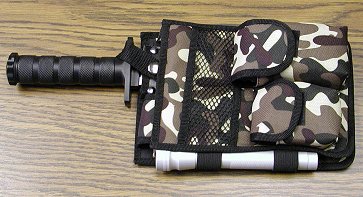
Commercially purchased survival
kit.
If you don’t want to spend the time it takes to
accumulate a kit of this type, you can simply purchase one. The imported
survival kit shown here should cost you around $30 USD or less. It
contains several essential pieces of survival gear: a hollow-handled knife
(containing the usual prepackaged items), flashlight, compass, multitool,
and mini-binoculars.
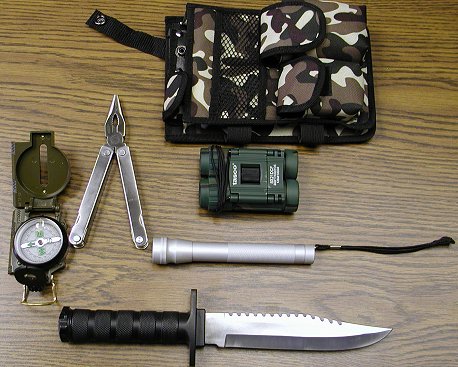
Compass, multitool, knife,
binoculars, and light are a good start for your kit.
Your on-body carry items should include some sort of
equalizing weapon, if you may carry one legally. A good pocket stick
or a Super Sharpie marker or Mini Mag-Lite that serves as one is very
helpful, as is a tactical folder. Obviously, if you can legally carry a
handgun or tote a rifle or shotgun in your car, you should do so. This
is not possible for everyone, but when you can, it’s the best “life insurance”
you can possess. When storing a weapon in your car, make sure it is locked up
securely and not visible from outside the vehicle. There are companies
that manufacture truck-bed safes, under-seat safes, and other security items
for this purpose. For the love of all that is holy, don’t put a shotgun
in a gun rack in your vehicle and leave it there unlocked.
All the gear assembled here sounds like more than it really is. I didn’t
assemble or purchase anything special to write this article. I just went out
to my car and then walked back into my office, cataloging the items that I’ve
tucked away for future emergencies. I didn’t assemble them all at once,
either; it was a gradual process of brainstorming and preparation.
On the road, in the office, or at the mall, you should know that you have
access to the tools and supplies you may need to handle adversity.
Get started now so that you, too, can be
prepared.
